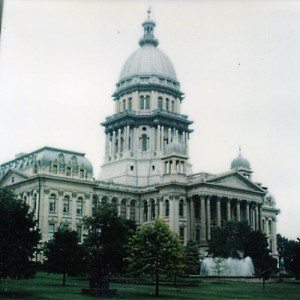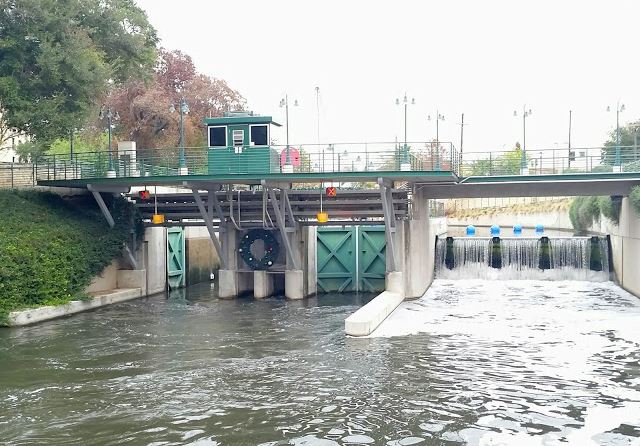We’ve seen Grant Park before, first in my post on Taste of Chicago, and then again in my post on Millennium Park (and we will see it once more in what will likely be my next Northern Illinois Destinations post, which is likely to be on the Art Institute of Chicago). I grew up within walking distance of a suburban park that was, according to my figures, about 30 acres. At 319 acres, you could fit that neighborhood park inside Grant Park over 10 times. This made Grant Park seem like the biggest park ever to me. Of course, it isn’t. It isn’t even the largest park in Chicago (though we never spent much time in Lincoln, Jackson, or Washington Parks, which are all larger than Grant Park, and none of these parks that I’ve mentioned are even among the hundred largest parks in the country).
I can’t find any hard statistics, but it certainly looks like Grant Park is the oldest park in Chicago. It would be hard for a park to be older, since the land was set aside for public use in 1836 and Chicago was incorporated as a town in 1833 and as a city in 1837. Since the Grant for whom the park was named is Ulysses S. Grant, the park was not always named for Grant. The original name of the park was the not-terribly-original “Lake Park.”
While the land of the then-Lake Park was to have been left open to keep the view of the lake available to everyone, over time buildings accumulated in the park, including a three-story exposition center where the Art Institute of Chicago building stands today. The Illinois Central Railroad also got a right-of-way along the lake shore in 1869. I am not sure what that did to the view, since they were in the process of raising the street level to alleviate flooding (and the consequent health hazards). I think they must have raised the park. After the Great Fire in 1871, they enlarged the park with debris from the fire, and apparently they have used landfill to enlarge the park more over time.
The Museum Campus, which is home to the Field Museum of Science and Industry, the John G. Shedd Aquarium, and the Adler Planetarium (the first planetarium in the United States, apparently), forms the southern boundary of Grant Park, the northern boundary is Millennium Park, the eastern boundary is Lake Michigan (of course), and the western boundary is Michigan Avenue.
In addition to the Field Museum, the Shedd Aquarium, and the Adler Planetarium, Grant Park is also home to Soldier Field, the Petrillo Music Shell (where I made my parents stick around after Taste of Chicago one year long enough to see Chicago perform one song), Buckingham Fountain, and the Art Institute of Chicago.
Chicago was pretty forward-thinking in terms of public art and Grant Park has accumulated a number of art pieces over the last century and a quarter. The oldest piece of art I can find is the Rosenberg Fountain. Joseph Rosenberg got his start as a newsboy in Chicago and he often was thirsty working in the hot sun. He made his fortune (at what, I have yet to determine) and in his will commissioned a public drinking fountain so that people who visited would not be thirsty. The monument is still a fountain, but the water is no longer available to drink, at least not officially. There are a lot more public drinking fountains in Chicago than there probably used to be, as well. The map lists eight “comfort stations” in the park (nine if you include Millennium Park) and where there is a “comfort station” there is usually a drinking fountain, in my experience.
The most prominent piece of art in the park is a statue of Lincoln by Augustus Saint-Gaudens that has sat in the park since 1926. For some unknown reason, there is no statue of Grant in Grant Park. To see a statue of Grant, you have to go to Lincoln Park. I love my hometown, but there are some things I just can’t explain.
Then there is my favorite piece of art in the park. Technically, it is a piece of architecture. While not as famous as its sibling in New York or the local Board of Trade, Chicago does have a stock exchange. At one time, the stock exchange was housed in a building designed by the firm of Adler & Sullivan. The old stock exchange building once stood on the corner of Washington and LaSalle Streets, kittycorner from the Chicago City Hall building. The building was demolished in 1972, and in a way, the demolition of the stock exchange building was the wake-up call that led to the preservation of so many historic buildings in Chicago since then. Unfortunately, the only part of the stock exchange building that remains is the entrance arch, which stands behind the Art Institute. They erected the arch in the park in 1977 and I think I discovered that it was there not too long after that. The home of the Goodman Theatre used operate out of a theater on the Art Institute grounds and my mom and the cousin we used to visit in Florida took my first cousins once removed and me to a Children’s Theater play there in what would have been 1978. On the way out of the theater, I saw the arch and, much to my mother’s confusion, it was love at first sight.
Near as I can tell, Grant Park is wheelchair accessible. Frequently, the website for a place will come right out and say it, but I can’t find anything definitive. Millennium Park’s website says that it is; Grant Park’s not so much. However, it’s Chicago, so the ground is level. I seem to recall some stairs, maybe at Congress Plaza, and I’m almost certain that there are stairs leading up to the Lincoln statue, and I don’t know if there are ramps there. The intersections all have curb cuts, from what I can see on Google Maps.


